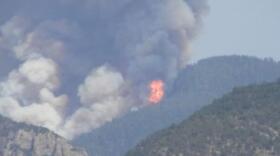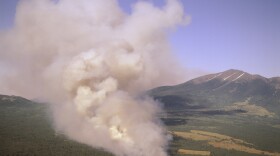Over the past several days, writers Rose Houk and Michael Collier have been reporting on the plight of our ponderosa pine forest and efforts to restore its health. In this final installment, we look at industry’s role, and what the public can expect to see when restoration gets underway.
Loggers rarely use chainsaws in the woods anymore. Instead they wheel around in machines called feller-bunchers.With giant claws, the machines pinch off fifty-foot ponderosa pines like toothpicks, and drop them into piles waiting for loaders.
This is likely the way loggers will harvest trees once the Four Forest Restoration Initiative is underway. A healthy local logging industry is critical to 4FRI because the Forest Service simply cannot afford to pay for thinning. In the past, it cost taxpayers upwards of $500 an acre. But under the recently awarded 4FRI contract, Pioneer Forest Products will pay the government an average of $21 per treated acre. Pioneer will employ 500 or 600 people to log and to process the wood in a mill it will build in Winslow.
“Pioneer has no experience logging; we’re a start-up,” says Marlin Johnson. Retired from the Forest Service, Johnson is now Pioneer’s chief forester. He speaks of the company’s plans for 2013: “Our target right now, and I think we can meet it, is by about this time next year, we’ll have a log yard ready in Winslow to take delivery of logs. And shortly after that the sawmill portion will be ready to start up and processing those, say in the fall of 2013. But right now, there’s nothing.”
The Forest Service, with the help of 4FRI collaborators, will lay out details of the actual cutting in what are called “prescriptions.” The workforce will need to be specially trained in how to fill each prescription.
Steve Gatewood, of the Greater Flagstaff Forest Partnership and a 4FRI collaborator, describes how it will translate on the ground. “The prescription actually says we want to leave an uneven-aged mix of trees, uneven size of trees, and we want to leave groups and clumps, but you get to pick where the interspaces go, where the openings go, and which trees to remove from the groups and clumps.”
Close to towns, mechanical thinning is likely to be extensive. Farther away, thinning may be less severe. Old ponderosas, sensitive wildlife species, and springs and streams will require more selective cutting. Prescribed burning will follow in most places, and some areas could see additional thinning in the future.
Monitoring--short and long term--will be integral to 4FRI. Shaula Hedwall, with the U.S Fish and Wildlife Service, notes that “The big key is using our monitoring to be able to adapt quickly so that we can modify prescription techniques. And not get stuck in a process of ‘this is the way we’ve always done it.’ The way we’ve always done it may not work for the long term.”
Not so long ago, 10,000-acre treatments were considered big projects. But 4FRI will ramp up to 50,000 acres a year if all goes as planned. The public can expect to see and hear a lot of activity. Logging will be noisy, in some cases close to homes. Skid trails will run up hillsides. Big trucks will make 120,000 trips in and out of the woods every year. County roads will take a beating.
Grand Canyon Trust’s Marcus Selig thinks people need to be forewarned. “Folks are going to be surprised when they see the forest right after treatments. It’s going to be shocking to people at first when move from 400-500 trees down to 50 trees per acre.”
Then, Selig adds, there’s the smoke. “Fire and smoke is something folks aren’t going to be happy to deal with but is a part of a healthy forest.”
4FRI is close to reality--closer than it’s ever been. But for many of the stakeholders, there’s plenty of uncertainty to go around.
For Ed Smith of The Nature Conservancy, “What keeps me up at night about the Four Forests Restoration Initiative is that it’s huge.” Todd Schulke of Center for Biological Diversity says, “I’m actually more worried about the failure of industry.” And 4FRI team leader Henry Provencio, offers his concerns: “What keeps me up at night is relationships and trust.”
The Four Forest Restoration Initiative may offer the best hope of revitalizing the ponderosa forest. 4FRI is ambitious but doing nothing is not an option.
This series on 4FRI is funded in part by the Grand Canyon Trust.










